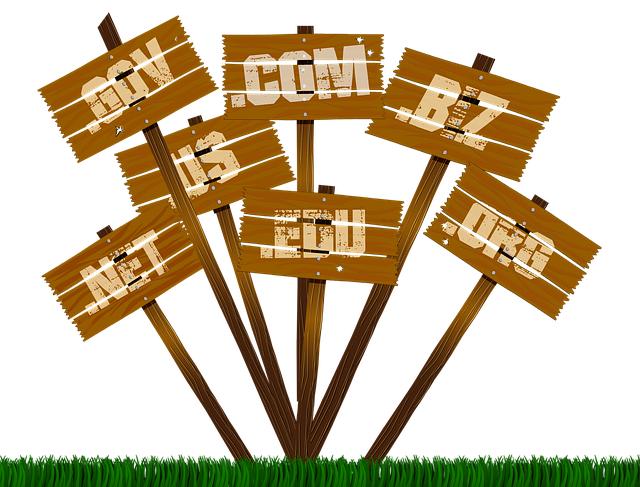Table of Contents
- Understanding the Domain Name Market and Its Potential
- Crafting the Perfect Domain Name for Maximum Appeal
- Strategies for Pricing Your Domain Name Competitively
- Effective Marketing Techniques to Sell Your Domain Names
- Navigating the Transfer Process: Tips for Smooth Transactions
- Q&A
- In Summary


Understanding the Domain Name Market and Its Potential
The domain name market is thriving, shaped by a growing demand for online presence that continues to rise in both established businesses and startups. With millions of websites clamoring for attention, the right domain name can become a valuable digital asset. The allure of premium domains lies not only in their marketability but also in their ability to convey credibility and relevance to a target audience. As digital transformation accelerates, recognizing this potential can turn domain name registration into a lucrative venture.
When delving into the intricacies of the domain market, it is essential to consider the factors influencing value, such as keyword relevance, length, and brandability. Potential buyers often seek domains that are:
- Memorable – A catchy domain name improves recall and increases the likelihood of return visits.
- SEO-friendly – Keywords in domain names can boost search engine rankings, attracting organic traffic.
- Short and Simple – Simple domains reduce the risk of typos and make sharing easier.
Exploring avenues for buying and selling domain names can open up diverse income possibilities. Investors often engage in various strategies to capitalize on market demand, such as:
| Strategy | Description |
|---|---|
| Domain Flipping | Buying low and selling high through market analysis and trends. |
| Parking Domains | Monetizing unused domains via advertising while awaiting a sale. |
| Long-Term Investment | Holding valuable domains with the potential for appreciation over time. |
Crafting the Perfect Domain Name for Maximum Appeal
Choosing the right domain name is crucial for anyone looking to sell online. A well-crafted domain can communicate your brand identity, create credibility, and enhance overall visibility. Start with a name that is short, memorable, and easy to spell. This helps to ensure that potential buyers can effortlessly recall and access your site. Additionally, aim for a domain that hints at your niche, giving visitors an immediate understanding of what you offer. For example, if you specialize in vintage clothing, a name like “RetroThreads.com” can instantly convey your focus.
Consider incorporating relevant keywords in your domain name to improve search engine optimization (SEO), which can assist in attracting organic traffic. You should also evaluate domain extension options; while “.com” remains the most recognized, other extensions such as “.shop,” “.store,” or “.online” may perfectly align with your brand’s vision. Ultimately, ensure that your chosen name stands out from competitors while maintaining a professional image.
| Tips for Choosing a Domain | Description |
|---|---|
| Keep It Short | Less is more—shorter names are easier to remember. |
| Be Descriptive | Include keywords that reflect your brand or niche. |
| Avoid Hyphens | Hyphens can confuse users and hurt memorability. |
| Consider Local SEO | If your market is local, integrating location can help. |


Strategies for Pricing Your Domain Name Competitively
When it comes to pricing your domain names, a strategic approach can make all the difference in attracting buyers and maximizing your profits. Researching market trends is essential; by examining similar domains and their selling prices, you can gain valuable insights into what potential buyers are willing to pay. Tools like Estibot or NameBio can provide historical sales data and appraisals to help you establish a competitive baseline. Remember to consider factors like domain length, keyword relevance, and brandability when evaluating market prices.
It’s also beneficial to adopt tiered pricing strategies, which can cater to a wider audience. You might consider setting different price points based on domain attributes. For example, premium domains could be priced higher due to their perceived value, while lesser-known or longer domains may attract buyers with more budget-conscious options. This approach not only widens your potential customer base but also creates opportunities for negotiation and upselling based on buyer interest. Here are a few pricing strategies to consider:
- Competitive pricing: Match or slightly undercut your competitors.
- Value-based pricing: Set prices based on perceived value to the buyer.
- Discount offers: Provide special promotions or discounts for first-time buyers.
Additionally, being transparent about your pricing can foster trust with potential buyers. You may want to include pricing tables that clearly outline what is included with each domain purchase. Here’s a simple example of how you might structure your pricing options:
| Domain Type | Price | Included Features |
|---|---|---|
| Standard Domain | $10 | 1-year registration, basic support |
| Premium Domain | $100 | 5-year registration, advanced support, free website builder |
| Business Bundle | $500 | 10-year registration, premium support, SEO tools |
By implementing these strategies, you can position your domain names in a way that appeals to a diverse range of buyers while ensuring you stay competitive within the marketplace.


Effective Marketing Techniques to Sell Your Domain Names
When it comes to selling domain names, the right marketing techniques can make all the difference. Start by leveraging social media platforms to reach a wider audience. Create dedicated profiles on popular sites like Facebook, Twitter, and Instagram where you can showcase your domain offerings. Use visually appealing content—such as graphics, videos, and infographics—to grab attention and spark interest. Don’t forget to engage with your audience through comments and messages, as building relationships can significantly boost your sales potential.
Another powerful method is to optimize your listings on domain marketplaces. Use clear, keyword-rich titles to enhance searchability. Make sure to highlight the unique selling points of your domains, such as their length, memorability, and relevance to current trends. To help potential buyers visualize their future success with the domain, consider creating a brief table that outlines possible uses and target markets:
| Domain | Potential Use | Target Market |
|---|---|---|
| HealthyBites.com | Health Blog | Nutrition Enthusiasts |
| TechieGadgets.net | Review Site | Gadget Lovers |
| WanderlustAdventures.org | Travel Community | Travel Aficionados |
Lastly, don’t underestimate the power of email marketing. Build a list of interested potential buyers by offering valuable content or services related to domain name use. Regular newsletters showcasing your available domains, success stories, or the latest industry trends can keep your audience engaged and informed. By providing useful insights and maintaining consistent communication, you can drive interest and create opportunities for sales conversions.


Navigating the Transfer Process: Tips for Smooth Transactions
Successfully transferring domain names requires meticulous planning and a clear understanding of the process. Before initiating the transaction, it’s essential to prepare your domain by ensuring that all information is up-to-date. This includes verifying your WHOIS information, which should reflect the correct registrant contact details. Additionally, unlock the domain and disable any privacy protection features to avoid unnecessary delays during the transfer process.
Communication is key during the transfer. Both parties should maintain clear and open lines of communication to avoid misunderstandings. Here are some best practices to consider:
- Establish a Timeline: Set a mutual deadline for the transfer, ensuring both parties are aligned on expectations.
- Confirm Transfer Codes: Share the authorization code securely and verify its accuracy to prevent issues.
- Check Registrar Policies: Familiarize yourself with the policies of both your current and new registrar to avoid unexpected roadblocks.
It’s also beneficial to keep a close eye on the transaction’s progress. Utilize tracking systems provided by registrars to monitor the status of the transfer. To further ensure a smooth transaction, consider these important tips:
| Tips | Details |
|---|---|
| Double-Check Domain Lock Status | Ensure that the domain is unlocked to allow transfer. |
| Monitor Expiration Dates | Try to initiate the transfer well before the domain expires. |
| Have Backup Communication Methods | Be ready with alternative contact methods in case of technical difficulties. |
Q&A
Q&A: Selling Online Domain Names
Q1: What is a domain name, and why is it important for businesses? A1: A domain name is the web address that people use to find your website—essentially, it’s your online identity. For businesses, having a relevant and memorable domain name enhances brand recognition, builds credibility, and improves search engine visibility. It’s often the first impression potential customers will have of your brand.Q2: How do I choose a good domain name for resale? A2: A good domain name for resale should be short, memorable, and easy to spell. Consider using popular keywords related to emerging trends, industries, or technologies. Extensions like .com, .net, and .org tend to have higher value, but niche extensions can also be lucrative if tied to specific sectors. Conduct keyword research to determine what might attract the most buyers.
Q3: Where can I sell my domain names? A3: You can sell domain names through various platforms, such as GoDaddy, Sedo, and Flippa, which specialize in domain trading. Online marketplaces and auction sites allow you to list your domain and connect with potential buyers. Additionally, leveraging social media and domain forums can help you reach a wider audience.
Q4: What factors influence the value of a domain name? A4: Several factors can determine the value of a domain name, including length, keyword relevancy, comparable sales in the market, and the popularity of the domain extension. Unique and brandable names often fetch higher prices. Additionally, historical data about the domain (like previous ownership and use) can also impact its value.
Q5: How can I effectively market my domain names? A5: To market your domain names effectively, create a professional website showcasing your listings, complete with descriptive text and pricing. Use search engine optimization (SEO) strategies to enhance visibility. Utilize social media channels and online advertising to attract potential buyers. Networking in relevant forums and communities can also help spread the word about your domain portfolio.
Q6: Can I use my domain name for more than just selling? A6: Absolutely! You can use your domain name to create a website, host a blog, or even develop an online business. If you choose to park the domain, you can earn revenue through ads. This approach can be a great way to build value while waiting for the right buyer.
Q7: What are the risks of selling domain names? A7: Risks include potential scams, the possibility of getting stuck with a domain that doesn’t sell, or overestimating its worth. It’s essential to conduct due diligence and research to avoid pitfalls. Also, ensure you understand legal aspects, such as trademark issues, to protect yourself during the selling process.
Q8: How do I complete a domain sale transaction securely? A8: To ensure a secure transaction, use a reputable escrow service, which can help protect both the buyer and seller during the exchange of money and domain ownership. Always verify the buyer’s legitimacy and avoid sharing sensitive information until you are sure of the transaction’s security.
Q9: What’s the best way to stay updated on domain selling trends? A9: Stay informed by following industry blogs, participating in forums, and subscribing to domain newsletters. Joining domain investor communities can provide insights into market trends and valuable tips from seasoned sellers. Networking can also lead to learning about upcoming opportunities or risks in the domain market.
Q10: Is selling domain names a profitable venture? A10: Selling domain names can be profitable, especially with the right approach and research. Many individuals and businesses are looking for unique domain names, which can translate into significant financial gain. However, success often requires patience, a keen understanding of market dynamics, and marketing savvy.

